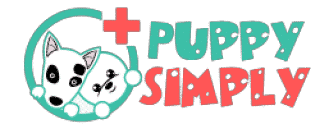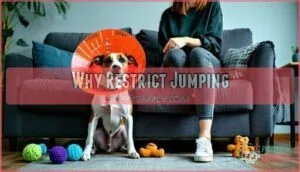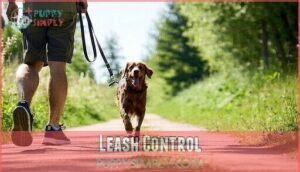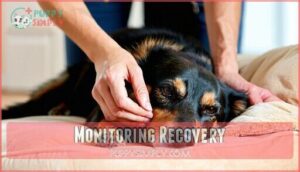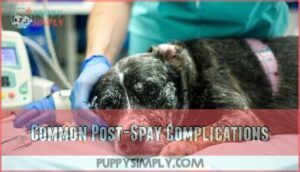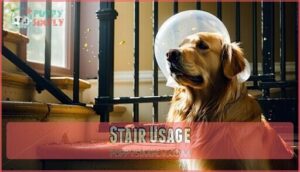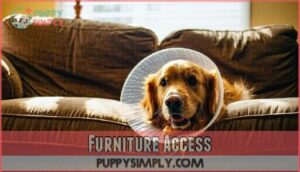This site is supported by our readers. We may earn a commission, at no cost to you, if you purchase through links.
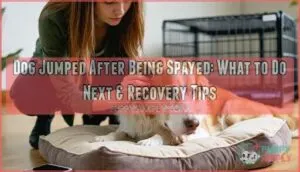
First, check the incision site for any signs of opening, bleeding, or swelling – these red flags need immediate veterinary attention.
Don’t panic, but don’t wait either, as even if everything looks normal, that leap could’ve stressed internal sutures you can’t see, which is a potential cause for complications.
Contact your vet right away to describe what happened and get professional guidance, and meanwhile, restrict her movement completely using a crate or small room to prevent further stress.
The next few hours are vital for determining if complications developed from her impromptu gymnastics routine.
Table Of Contents
- Key Takeaways
- Spay Surgery Risks
- Why Restrict Jumping
- Post-Spay Care Tips
- Preventing Jumping Behavior
- Monitoring Recovery
- Common Post-Spay Complications
- Managing Hyperactivity
- Safe Activity Resumption
- Promoting Smooth Recovery
- Reducing Jumping Risks
- Frequently Asked Questions (FAQs)
- What happens if my dog jumps after spaying?
- How long after being spayed can a dog go upstairs?
- How long to limit jumping after spay?
- How do you know if something is wrong after spaying?
- Can my dog eat normal food after spaying?
- When can my dog take a bath post-surgery?
- Should I expect personality changes after spaying?
- How long should my dog wear the cone?
- Can I give pain medication with food?
- Conclusion
Key Takeaways
- Contact your vet immediately if your dog jumps after spaying – even if the incision looks normal, internal sutures could be damaged and need professional evaluation.
- Restrict all movement completely using a crate or small room for the next 10-14 days to prevent further complications like wound reopening or internal bleeding.
- Monitor the incision site closely for warning signs, including redness, swelling, bleeding, discharge, or gaps in the surgical line that indicate serious complications.
- Implement strict jumping prevention by removing furniture access, using baby gates on stairs, and keeping your dog on a short leash during bathroom breaks.
Spay Surgery Risks
When your dog jumps after spay surgery, you’re facing serious risks that could derail her recovery completely.
The sudden movement can tear internal sutures, reopen wounds, or cause dangerous complications that require emergency veterinary care.
Post-Surgery Complications
Unfortunately, up to 20% of dogs experience post spay complications like wound infection, suture failure, and excessive postop pain.
When your dog jumped after spay, you’ve increased the risk of these spay surgery risks substantially.
Recovery time extends when complications arise, so watch for complication signs including bleeding, swelling, or discharge from the incision site during spay surgery recovery.
It’s vital to monitor for post operative issues to guarantee a smooth recovery.
Internal Suture Rupture
When your dog jumped after spay surgery, internal suture rupture becomes a serious concern.
The vigorous movement can snap internal stitches holding muscle layers together, potentially causing internal bleeding or hernias.
This suture damage creates abdominal strain that compromises proper healing.
Immediate postop care includes monitoring for signs like lethargy, pale gums, or abdominal distension.
If internal suture breakage occurs, surgical repair may be necessary to prevent life-threatening complications during recovery.
Wound Reopening
When internal sutures fail, your dog’s incision site faces wound reopening risks. This postspay complication occurs when suture damage allows the surgical site to separate, creating an open wound that’s vulnerable to infection.
Healing delays become inevitable as the body must restart tissue repair. Your dog jumped after spay surgery, so watch for gaps in the skin or tissue protruding from the incision.
PostOp monitoring of the wound infection signs includes redness, swelling, or discharge. Proper incision care prevents these serious complications from developing further.
Why Restrict Jumping
When your dog jumps after spay surgery, you’re looking at real risks that can derail her recovery.
Those internal sutures holding everything together aren’t meant to handle sudden pressure from jumping, and breaking them can lead to serious complications like infection or prolonged healing.
Suture Breakage
When your dog jumped after spay surgery, the forceful movement puts tremendous stress on healing tissues.
Suture breakage becomes a real concern that can derail recovery.
Here’s what creates suture damage:
- Body wall sutures snap first under pressure from jumping motions
- Skin sutures tear when internal tissues pull against the incision
- Healing issues develop when ripped sutures can’t hold tissues together
- Postop care becomes critical to prevent suture failure complications
Watch for gaps in the incision or tissue protruding—signs your dog’s surgical site needs immediate attention.
Infection Risk
Jumping after spay surgery creates infection risks through wound disruption and bacterial contamination.
When your dog’s incision reopens from sudden movement, bacteria can enter the surgical site, leading to serious complications.
PostOp monitoring becomes vital as infection signs include redness, swelling, discharge, or foul odor.
Proper wound care and infection prevention require strict activity restrictions during healing.
It’s essential to follow the veterinarian’s instructions for post operative care to minimize the risk of infection and promote a smooth recovery.
Prolonged Healing
When your dog jumps after spay surgery, healing time extends substantially beyond the normal recovery period.
Each instance of excessive activity disrupts the delicate wound healing process, potentially adding weeks to your pet’s recovery timeline.
Key factors that prolong dog spay recovery:
- Wound care complications – Jumping tears internal sutures, creating additional tissue damage that requires extended healing
- Infection risks increase – Open wounds from movement provide entry points for bacteria, complicating recovery
- Scar management issues – Repeated trauma creates thicker, more problematic scar tissue formation
- Pain relief requirements – Extended discomfort necessitates longer medication periods and monitoring
- Postspay complications – Internal bleeding and seromas develop more frequently with premature activity
Post-Spay Care Tips
When your dog jumps after spay surgery, you’ll need to implement strict activity restrictions and monitoring to prevent complications.
The key is using crate training, leash control, and calming aids to keep your pet calm during the critical 10-14 day recovery period.
Crate Training Benefits
A well-prepared crate becomes your dog’s recovery sanctuary after spay surgery.
Crate training benefits include creating a calm environment that reduces anxiety and prevents risky movements. Your pup can’t jump onto furniture or race around when safely contained.
This controlled space promotes healing while giving you peace of mind. Properly selecting a crate involves considering factors related to dog crate sizes.
| Crate Safety | Dog Comfort | Reduced Anxiety |
|---|---|---|
| Prevents jumping accidents | Familiar, secure space | Minimizes stress responses |
| Controls movement safely | Soft bedding for rest | Quiet recovery zone |
| Eliminates furniture access | Easy monitoring | Predictable routine |
Leash Control
Short leash usage helps prevent your dog from making sudden movements that could damage healing sutures.
A six-foot leash provides enough freedom for bathroom breaks while maintaining control.
Keep your dog close during walks to monitor behavior and prevent unexpected jumps.
- Use a short leash (4-6 feet) to limit sudden movements and maintain close supervision during recovery walks
- Practice calm commands like "easy" or "slow" to encourage gentle handling and controlled movement patterns
- Implement walk techniques that avoid exciting stimuli like other dogs, which could trigger jumping behavior
Calming Aids
Calming aids can help reduce your dog’s post-surgery anxiety and restlessness.
Pheromone therapy releases comforting scents that mimic natural dog pheromones, while calming treats containing natural supplements like chamomile work within thirty minutes.
Anti-anxiety aromatherapy and CBD supplements offer additional relaxation techniques.
These calming techniques help prevent hyperactive behavior that leads to jumping.
Many owners find relief using calming dog supplements to soothe their pets, which can be considered post-surgery anxiety solutions.
Preventing Jumping Behavior
You can take several steps to stop your dog from jumping after spay surgery and protect the healing incision.
Creating a safe environment and using proper restraints will help your dog recover smoothly without complications.
Environmental Adjustments
Creating the right environment blocks dog jumping after spay surgery.
Remove furniture access by blocking stairs with baby gates and covering couches.
Home modifications include rearranging rooms to eliminate jumping temptations.
Gate installation prevents stair access during recovery period.
Room rearrangement keeps essentials at floor level.
Calming environments with comfortable ground-level bedding encourage rest.
These environmental adjustments support healing while maintaining your dog’s comfort throughout the critical recovery phase.
Using Restraints
When environmental changes aren’t enough, physical restraints become your backup plan.
A short leash keeps your dog close during indoor supervision, preventing sudden jumps.
The Elizabethan collar (dog cone) stops wound licking while limiting mobility.
Crate training provides controlled rest periods, though avoid immediate post-surgery crating.
Leashed walks allow bathroom breaks without freedom to bounce.
These restraint methods work best when combined with patience and consistent enforcement.
Mental Stimulation
While restraints help control movement, keeping your dog’s mind engaged reduces the urge to jump.
Bored dogs often bounce around seeking stimulation, but mental activities tire them out more effectively than physical exercise during postspay recovery.
- Puzzle Toys – Hide treats in interactive feeders to encourage calm problem-solving
- Brain Training – Teach simple commands or tricks while your dog rests
- Gentle Play – Engage in low-energy games like "find the treat"
- Interactive Games – Use snuffle mats or slow-feeder bowls for mental enrichment
Monitoring Recovery
After your dog jumps following spay surgery, you’ll need to watch for specific warning signs that indicate complications.
Check the incision site regularly for redness, swelling, bleeding, or unusual discharge that could signal infection or suture failure.
Signs of Complications
Watch for these red flags that signal spay complications requiring immediate veterinary attention.
Wound infection appears as redness, heat, or bad odor around the incision site.
Suture failure shows gaps in the surgical line, while post op bleeding produces fresh blood or bloody discharge.
Swelling signs include firm lumps or fluid pockets near the wound.
Discharge issues involve pus, excessive fluid, or unusual drainage from the incision area.
Incision Site Care
Check your dog’s incision twice daily for proper healing and early warning signs.
Look for redness, swelling, bleeding, or unusual discharge around the surgical site.
Keep the area clean and dry, gently dabbing with a damp cloth if needed.
Don’t apply ointments unless your vet specifically recommends them for wound care and scar management during the healing process.
Veterinary Guidance
Contact your veterinarian immediately if your dog shows concerning signs after jumping post-spay surgery.
Vet consultation becomes necessary when you notice bleeding, swelling, or behavioral changes that indicate spay risks.
Your vet provides essential postoperative care guidance and recovery tips to guarantee pet safety during the healing process after spay surgery.
Common Post-Spay Complications
When your dog jumps after spay surgery, you’re risking several serious complications that can derail her recovery.
The most common issues include open wounds from broken sutures, fluid-filled seromas, and potentially dangerous internal bleeding.
Open Wound
If your dog’s incision site splits open after jumping, you’re facing an emergency situation that requires immediate veterinary attention.
An open wound exposes internal tissues to bacteria, dramatically increasing infection risk and complicating the healing process. You’ll notice gaps in the skin where sutures have failed, possibly with tissue protruding from the incision site.
Keep your dog calm and apply gentle pressure with clean gauze to control bleeding while heading to your vet for suture repair. It’s vital to follow proper safe lifting techniques to prevent further injury and promote healing, ensuring a smooth healing process.
Seroma
Beyond open wounds, another common complication you’ll encounter is seroma formation. This fluid accumulation occurs when clear liquid collects in spaces between healing tissues, creating soft lumps near your dog’s incision site.
Watch for these seroma warning signs:
- Soft, squishy swelling that feels like a water balloon under the skin
- Clear or yellowish fluid occasionally draining from the incision
- Gradual lump development appearing 7-10 days post-surgery
- Non-painful swelling that doesn’t feel hot or cause discomfort
Most seromas resolve naturally within 1-2 weeks through strict activity restriction and proper wound care. Apply warm compresses to promote fluid resorption, but avoid draining attempts due to infection risks. Monitor your dog’s incision site daily for changes in swelling management, and contact your vet if the seroma becomes painful, hot, or shows signs of infection.
Internal Bleeding
While seromas represent visible fluid accumulation, internal bleeding poses a more serious threat to your dog’s recovery.
Vascular damage from jumping can rupture internal stitches, creating blood clots or hematoma risk beneath the incision site.
This bleeding signs often remain hidden until severe complications develop.
| Warning Signs | Action Required |
|---|---|
| Pale gums, weakness | Emergency vet visit |
| Abdominal swelling | Immediate assessment |
| Rapid breathing | Critical intervention |
| Cold extremities | Urgent care needed |
| Restlessness, panting | Professional evaluation |
Monitor your dog’s incision site monitoring for subtle changes that indicate internal injury beyond surface-level seroma formation.
Managing Hyperactivity
If your dog jumped after being spayed, you’re dealing with a common but concerning situation that requires immediate attention to prevent complications.
Managing post-surgical hyperactivity involves implementing strict exercise restrictions, using proven calming techniques, and providing appropriate mental distractions to keep your recovering pet safe.
This situation requires a comprehensive approach, including strict exercise restrictions and calming techniques, to ensure your dog’s safe recovery.
Exercise Restrictions
Your dog’s body needs time to heal properly after spay surgery.
Restrict all vigorous dog exercise for 10-14 days to prevent complications.
Follow strict leash rules during potty breaks—no running or rough play allowed.
Choose calm exercises like gentle sniffing walks instead of energetic activities.
Quiet activities and restricted movement help guarantee successful healing while preventing dangerous dog jumping that could rupture internal sutures.
Calming Techniques
Creating calm environments helps manage your dog’s post-spay hyperactivity naturally. Gentle touch and soothing sounds work together to promote relaxation during recovery.
- Gentle Touch: Light petting and massage reduce stress hormones while promoting healing
- Soothing Sounds: Dog calming music or white noise masks outside stimuli that trigger excitement
- Pheromone Use: Adaptil diffusers release calming pheromones that create peaceful spaces naturally
- Natural Supplements: CBD supplements and calming aids provide relaxation without sedation side effects
Distraction Methods
Interactive toys offer excellent mental stimulation while your dog recovers from spay surgery.
Puzzle feeders, treat-dispensing balls, and snuffle mats keep her mind busy without encouraging jumping or vigorous movement. These calm exercises redirect energy into safe activities during play restriction periods.
Gentle petting sessions and quiet timeouts help manage dog behavior postsurgery.
Maintaining appropriate activity levels through dog rehabilitation requires balancing rest with controlled engagement, which can include gentle petting sessions, puzzle feeders, and other calm exercises to ensure a smooth recovery.
Safe Activity Resumption
Once your dog’s initial recovery period passes, you’ll need to gradually reintroduce normal activities to prevent complications while promoting healing.
The timeline for resuming stairs, furniture access, and regular exercise depends on your dog’s healing progress and your vet’s specific recommendations.
Timeline for Normal Activities
Your dog’s recovery timeline follows a predictable pattern that helps you plan ahead.
Most dogs can resume normal activities after 14 days with veterinary clearance, though the healing process varies by individual.
During rest periods, activity levels should remain minimal for the first week, then gradually increase.
Post op care requires monitoring the recovery time closely, as internal sutures need four months to fully dissolve despite external healing appearing complete.
Ensuring a puppy proofed environment is essential for preventing accidents and promoting a safe recovery.
This includes creating an environment that supports the dog’s healing process and prevents complications, making post op care a critical component of the recovery timeline.
Stair Usage
Your dog’s recovery success hinges on proper stair safety during the critical healing period. Stairs pose significant jumping risks that can compromise surgical sites and extend your recovery timeline.
Here are 5 essential stair management strategies:
- Install Pet Gates – Block stair access completely for 10-14 days post-surgery
- Use Dog Ramps – Provide gentle inclines as safer alternatives to steps
- Create Step Blocks – Place barriers on individual steps to prevent climbing
- Establish Floor Beds – Set up comfortable sleeping areas on the main level
- Implement Physical Activity Limitation – Carry your dog when stair navigation is absolutely necessary
Dog activity restriction around stairs prevents suture breakage and promotes ideal healing. Stair usage should be completely avoided during the initial recovery phase.
Furniture Access
Most furniture should remain off-limits for two weeks after spaying surgery.
Couch restrictions and seat limiters help prevent dangerous jumping that could tear internal sutures.
Use furniture blocks or baby gates as jump deterrents around elevated surfaces.
Your dog’s recovery depends on rigorous movement prevention and proper dog restriction during this critical healing period.
Promoting Smooth Recovery
Your actions now directly impact how well your dog recovers from spay surgery.
Following proper post-operative care guidelines and staying alert for complications will help your furry friend heal faster and avoid setbacks, which is crucial for a faster recovery.
Owner Education
Knowledge empowers recovery success.
Understanding post-spay care reduces complications by 70% when you follow proper guidelines.
Monitor your dog’s incision daily for signs of infection or suture breakage.
Recognize warning signs like excessive panting, lethargy, or bloody discharge that require immediate veterinary attention.
Your awareness directly impacts healing outcomes and prevents costly emergency visits, which is crucial for overall recovery success.
Veterinary Follow-Up
Regular follow-up checks typically happen seven to ten days post-surgery, allowing your veterinarian to monitor incision healing and detect potential complications early.
These vet visits provide essential medical guidance for proper post op care, ensuring your dog’s recovery stays on track.
Your veterinary consultation includes thorough incision monitoring and adjustments to recovery management as needed.
Complication Prevention
Prevention strategies focus on proactive wound care and suture safety measures.
You’ll reduce spay complications by maintaining strict postop monitoring during the critical first two weeks.
Create a recovery environment that supports injury prevention through controlled access to furniture and stairs.
Monitor the incision site daily for signs of infection risks, and implement jumping prevention techniques like leashing indoors.
Proper postspay care includes mental stimulation to reduce restlessness while maintaining physical restrictions that protect healing tissues.
It’s vital to follow safe lifting techniques, such as those found at lifting techniques, to avoid putting pressure on the incision area.
Reducing Jumping Risks
You can substantially reduce jumping risks by using specialized products and calming aids designed for post-surgical recovery.
Recovery suits, baby gates, and veterinary-approved calming supplements work together to create a safer healing environment while keeping your dog comfortable during the critical first two weeks, which is a critical period for recovery.
Product Assistance
Several medical supplies and products can help manage your dog’s recovery after spay surgery.
Recovery cones prevent wound licking, while calming treats reduce hyperactivity that leads to jumping.
Medical supplies like bandages protect incisions if your dog jumped after being spayed.
Pet insurance covers unexpected vet consults for complications during dog spay recovery, ensuring proper postspay care and maintaining necessary dog activity restriction throughout healing.
The use of recovery cone products is essential for a smooth recovery process, and helps with proper postspay care.
Recovery Suit Benefits
Recovery Suits offer superior protection compared to traditional cones, creating a barrier between your dog’s mouth and the incision site.
These Medical Gear solutions support natural healing while maintaining comfort during the recovery period.
Recovery Suits provide three key advantages for postspay care:
- Complete incision site protection – Soft fabric prevents licking and scratching without restricting vision or movement
- Enhanced comfort – Breathable materials reduce anxiety and promote restful sleep during dog spay recovery
- Improved mobility – Dogs can navigate stairs and furniture safely while maintaining necessary dog activity restriction
These Healing Aids transform Post Op Care into a stress-free experience for both you and your pet.
Calming Aid Options
When recovery suits aren’t enough to keep your pup calm, calming aids offer extra support.
Pheromone therapy releases natural dog-appeasing chemicals that reduce anxiety.
Calming treats containing L-theanine and natural supplements help mellow hyperactive dogs.
Aromatherapy with lavender, gentle massage, and soothing music create peaceful environments.
CBD supplements provide additional relaxation benefits when veterinarian-approved for post-surgical recovery.
Frequently Asked Questions (FAQs)
What happens if my dog jumps after spaying?
Sure, your dog decided to test gravity after major surgery—classic timing!
Jumping can break sutures, cause bleeding, or create infections.
Minor jumps usually aren’t catastrophic, but watch for redness, discharge, or opened incisions and contact your vet immediately for issues like infections.
How long after being spayed can a dog go upstairs?
You can typically allow your dog to go upstairs 10-14 days after spaying, once initial healing occurs.
Carry her up initially or use ramps to prevent jumping, which could tear sutures and delay recovery.
How long to limit jumping after spay?
You’ll need to limit your dog’s jumping for 10-14 days after spaying to prevent suture complications and promote proper healing. This restriction helps avoid wound reopening and internal bleeding risks.
How do you know if something is wrong after spaying?
Watch for redness, swelling, bleeding, or discharge from the incision.
Monitor for lethargy, vomiting, appetite loss, or difficulty breathing.
Contact your vet immediately if you notice gaps in stitches, tissue protruding, or unusual behavior changes.
Can my dog eat normal food after spaying?
While you might worry about upsetting your dog’s stomach, you can typically resume normal food after spaying.
Start with small portions to verify she’s tolerating it well, then gradually return to regular feeding amounts.
When can my dog take a bath post-surgery?
Wait 10-14 days before bathing your dog after spaying surgery.
Water can soften sutures and increase infection risk at the incision site.
Use pet wipes for cleaning until your vet clears full baths.
Should I expect personality changes after spaying?
Like a gentle breeze settling after a storm, you’ll notice some behavioral shifts post-spay.
Hormonal changes can reduce aggression and roaming, while your dog’s core personality stays intact—just calmer overall.
How long should my dog wear the cone?
Your dog should wear the cone for 10-14 days after spaying, or until the incision fully heals and sutures dissolve. Don’t remove it early, even if she seems fine.
Can I give pain medication with food?
Can you safely mix medicine with meals? Yes, most post-surgical pain medications can be given with food to reduce stomach upset.
Check your vet’s specific instructions, as some medications work better on empty stomachs while others require food for proper absorption.
Conclusion
Remarkably, the same energy that made your dog jump after being spayed can become her greatest asset during recovery when properly channeled.
Your quick response prevents complications and guarantees proper healing. Remember, patience during these vital weeks determines long-term success.
With consistent care and professional guidance, your dog will return to her playful self safely and completely healed. You’ve learned the critical steps: immediate veterinary contact, movement restriction, and vigilant monitoring.
- https://pethelpful.com/dogs/Seromas-Bump-on-a-Dogs-Surgery-Incision
- https://todaysveterinarypractice.com/soft-tissue-surgery/update-on-ovariohysterectomy/
- https://pawleaks.com/dog-jumped-after-being-spayed/
- https://www.petmd.com/dog/procedure/dog-spay-surgery
- https://www.kingsdale.com/what-is-a-seroma-in-dogs-and-how-to-prevent-it
